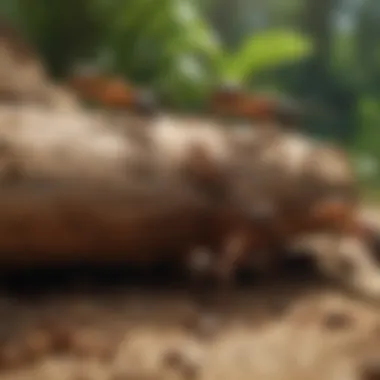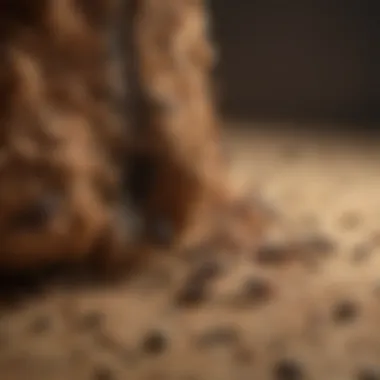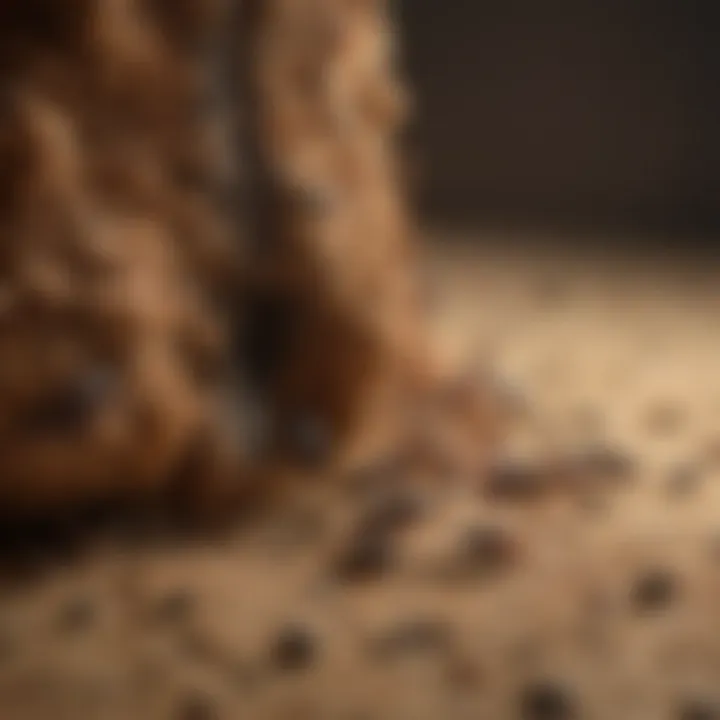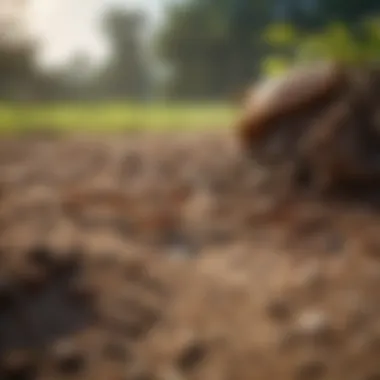Exploring Ants' Role in Termite Population Control


Intro
The relationship between ants and termites is a captivating one, interwoven in the fabric of ecological dynamics. These two groups of insects embody contrasting lifestyles, with ants often viewed as opportunistic predators, while termites are known primarily for their wood-eating habits and social structures. This article seeks to peel back the layers of this interaction, questioning whether ants actually kill termites, and if so, how this predation plays out in the greater tapestry of nature.
Throughout the discussion, we will explore the biology, behavior, and strategies employed by ants in their quest for survival, alongside the role of termites within their colonies. Understanding this predator-prey relationship isn’t just an academic exercise; it has tangible implications in many practical fields, including agriculture and pest management.
Topic Overview
Definition and Importance
Ants and termites belong to different taxonomic families, yet their interactions can significantly influence population dynamics in their habitats. Ants are omnivorous and can exhibit predatory behaviors, while termites primarily feed on cellulose found in wood and plant matter. This brings us to the crux of the matter: can ants effectively prey on termites? This question holds significance not just for understanding ecosystem interactions, but also for managing pests effectively in farming practices.
Brief History and Evolution
Ants and termites share a distant common ancestor, diverging millions of years ago. Ants evolved as more mobile, versatile insects, while termites developed complex social structures conducive for living in colonies. Throughout time, certain ant species have adapted strategies that allow them to invade and exploit termite colonies. Knowing the historical context helps us appreciate why this predator-prey dynamic is an ongoing and complex one in nature.
Key Techniques and Innovations
Sustainable Farming Practices
In agricultural settings, understanding ant and termite interactions can lead to more sustainable pest management methods. Farmers can promote beneficial ant populations which may help in naturally controlling termite numbers, minimizing the need for chemical pesticides. By fostering a healthy ecosystem, farmers can work alongside nature rather than against it.
- Rotate crops to promote biodiversity
- Encourage the growth of ant-friendly plants
- Implement natural barriers to termite infestation
Advanced Agronomic Technologies
Technological advancements can help monitor and manage pest populations more effectively. Drones and remote sensors are used to detect signs of termite activity before they become a full-blown problem. Understanding where ants are present in relation to termites can help target areas for intervention, ensuring a more balanced ecosystem.
Practical Applications
Step-by-Step Guides
To effectively manage the interplay between ants and termites, one can follow these practical steps:
- Identify the ant species typical to the region. Some might be more beneficial than others.
- Monitor termite populations to determine when intervention may be necessary.
- Create a conducive environment for beneficial ant species which can naturally suppress termite activity.
- Use technology to monitor both species and make informed decisions on pest management strategies.
Case Studies or Real-World Examples
Research has shown that in some regions, specific ant species, like Camponotus, have been successful in keeping termite populations under control. Farmers in these areas report fewer infestations and improved crop yields, demonstrating how the natural behavior of ants can be harnessed for improved agricultural outcomes.
To conclude, the predator-prey dynamics between ants and termites is not merely a fascinating study of entomology but a key component in understanding sustainable agricultural practices. As we delve deeper into this relationship, we are sure to uncover more secrets beneficial for farmers and agronomists alike.
"Understanding these ecological interactions is crucial for developing sustainable pest management strategies that benefit agriculture."
By unearthing these intricate dynamics, we not only enrich our knowledge but also empower farmers and specialists to make informed decisions in pest management.
Prelims
Understanding the relationship between ants and termites is not just an academic exercise; it's essential for grasping the intricacies of the ecosystems we inhabit. By diving into this predator-prey dynamic, we unveil significant ecological roles that both species play and how their interactions can ripple through agricultural practices. Farmers, ranchers, and agronomists all have a vested interest in this knowledge, as it poses both challenges and opportunities for land management.
Ants, often termed as nature's workers, and termites, known for their wood-eating habits, may seem like an odd pair to examine. However, their encounters often lean toward a predatory context, calling attention to the particular species of ants that target termites. This intricate dance of life spotlights not only survival but also indicates health indicators for larger ecosystems.
The Importance of Ants and Termites
Both ants and termites contribute significantly to nutrient cycling in soil. Ants aerate soil, facilitating water penetration, while termites help break down tough plant material, recycling it into a valuable fertilizer. This symbiotic balance ensures that ecosystems remain robust.
Moreover, considering their influence on soil structure and health, studies suggest that the decline or increase of either species can profoundly impact agricultural outputs. For example, an increase in certain aggressive ant species can help control termite populations, potentially sparing crops from deterioration.
Setting the Stage: A Brief Overview of Interactions


When we consider the interactions between ants and termites, it’s not just about survival instincts; it's also about evolutionary pressures. High-stakes encounters drive both species to adapt over generations. Predatory ants have developed diverse methods for attacking termites, which in turn encourages termites to evolve their defense mechanisms. It’s a continuous loop of adaptation and survival, one that speaks volumes about nature's balance.
The behaviors observed across various species offer a chance to analyze essential patterns that could inform pest management strategies. For instance, recognizing which ants prey on termites could lead to smarter choices in agricultural practices.
In summary, grasping the nuances of these interactions isn’t merely an academic pursuit; it’s a lens through which we can understand broader ecological dynamics and optimize agricultural practices. Tracking these interactions could forge pathways to sustainable farming and land use that benefits not just farmers but the ecosystems we all share.
Understanding Ants
Exploring the world of ants offers valuable insights into the predator-prey dynamics that shape ecosystems. Ants are not just passive players in their environment; they actively shape their habitats and influence the populations of other species, including termites. This section sheds light on key aspects that contribute to understanding why and how ants interact with other creatures.
Species Diversity and Habitats
Ants exhibit an astonishing diversity, with more than 12,000 species identified, adapted to a variety of habitats from tropics to arctic tundras. Each species has unique traits that contribute to its survival and ecological role. Some notable examples include the leafcutter ants, which are known for their complex symbiotic relationship with fungi. These ants cultivate fungi by feeding them plant material.
In contrast, fire ants are notorious for their aggressive defense mechanisms and can disrupt local ecosystems when introduced to new areas. The wide range of environmental adaptations means that ants can thrive in places such as deserts, forests, and urban settings, making their interactions with termites even more interesting to study. Each habitat modifies how ants behave, how they hunt, and what their relationship with termites might be.
Social Structure and Behavior
Ants are incredibly social creatures, often living in colonies numbering in the thousands to millions. Their social structure is hierarchical, comprising queens, workers, and drones, each with distinct roles. The queen's primary job is reproduction, while workers engage in tasks such as foraging, nest maintenance, and caring for larvae.
This social structure allows ants to coordinate collective activities, which can include attacking termite colonies. For instance, army ants, known for their organized raids, exhibit behavior where numerous individuals work together to overpower larger targets. The division of labor within an ant colony means that they can effectively strategize when interacting with termites, allowing for both sustained attacks and resource allocation.
Foraging Strategies
Ants adopt various foraging strategies based on their species and environmental conditions. While some hunt individually, many species employ a collective approach that capitalizes on their numbers. This involves scouting, which is executed by worker ants that search for food sources and create chemical trails to guide others.
A prime example of this would be the Argentine ant, which is notorious for establishing extensive foraging trails leading to food, including termites. Their persistence and teamwork efficiently neutralize threats and exploit resources. Additionally, some ants have evolved specialized behaviors, such as ambush tactics, to catch unsuspecting termites off guard. These foraging behaviors are crucial in determining the dynamics between ants and termites, revealing the complexity of their interactions and the methods ants use to compete for similar resources.
"Understanding the diversity, behavior, and strategic foraging methods of ants provides essential context for their interaction with termites and highlights the delicate balance of ecosystems."
Exploring Termite Biology
Understanding termite biology is crucial for grasping the dynamics of their interactions with ants. This section pulls back the curtain on the intricacies of termite life. By delving into their types, social structures, and feeding habits, we can better appreciate their ecological role and the challenges they face in environments where predatory ants operate.
Types of Termites and Their Roles
Termites are often categorized into three main types: subterranean, drywood, and dampwood. Each type plays a unique role in the ecosystem. Subterranean termites, as the name implies, live underground, constructing elaborate tunnel systems. These critters are notorious for damaging wooden structures, making them a concern for many homeowners.
On the other hand, drywood termites don’t require contact with soil, as they feast on wood with a moisture content of less than 12%, typical in sawn timber. Dampwood termites prefer decaying wood that harbors enough moisture, which can sometimes be found in rotting trees or logs.
Each type not only impacts the health of forest ecosystems but also presents varying challenges in pest management for farmers. For instance, while subterranean termites can disrupt crop roots, drywood termites often invade homes and structures. Understanding these distinctions allows farmers to tailor their pest management strategies accordingly.
Colony Structure and Function
Termite colonies are marvels of social organization. A single colony can house thousands, even millions, of individuals. At the top of this hierarchy is the reproductive pair: the king and queen. Their primary role revolves around producing new termites to sustain the colony.
Beneath them are workers, the unsung heroes of the colony, handling foraging, building, and caring for the young. There's also a soldier caste whose job is to defend the colony from predators such as ants. This structure grants termites a robust defense mechanism. In cases where these soldiers face threats, they often sacrifice themselves to protect their kin, highlighting a unique aspect of their social behavior.
"The structure of termite colonies is not just about roles but also about survival, where sacrifice plays a pivotal role in the collective welfare."
Feeding Habits and Nutritional Needs
Termites are essential decomposers in many ecosystems. They primarily feed on cellulose, which they obtain from wood and plant matter. This ability to digest cellulose comes from symbiotic organisms in their guts—microbes and protozoa—that break down the tough materials, making nutrients available for absorption.
Through their feeding habits, termites contribute significantly to nutrient cycling. They transform dead plant material into usable forms for other organisms, ensuring the health of the soil. Furthermore, their tunnelling aerates the soil, enhancing water infiltration and root growth for nearby plants.
Recognizing these feeding habits is just as important for farmers managing crops. Understanding what termites eat—like specific crop residues—can help inform integrated pest management practices that balance environmental health with agricultural productivity.
In summary, thoroughly exploring termite biology illuminates their ecological role. By understanding the types of termites, their social structures, and their feeding needs, we can develop more nuanced strategies for managing these fascinating yet challenging insects.


The Ant-Termite Interaction
Understanding the relationship between ants and termites is more than just exploring a fascinating predator-prey dynamic; it serves as a window into the complex interplay of ecosystems. The significance of this topic extends beyond mere curiosity; it holds essential implications for agriculture, pest management, and ecological balance.
As we delve into this interaction, we’ll uncover how the presence of ants can influence termite populations, which in turn can affect soil health and plant growth. Ants, often considered a farmer's ally, might not just be scavengers but vital players in maintaining a balance between beneficial insects and potential pests. By investigating this intricate connection, we can derive insights applicable for sustainable farming practices and effective pest management strategies.
Predatory Ants: Who Are They?
Predatory ants are more than a few bad apples in a vast orchard of species. These ants, such as the notorious Formica rufa and Pheidole species, have developed specialized roles within their colonies that favor hunting down termites. Their adaptations—both behavioral and physiological—make them formidable predators, equipped with strong mandibles and an acute sense of smell.
In many ecosystems, these ants function as natural checkers for termite populations. Some species even exhibit a degree of specialization, targeting specific termite types, allowing them to thrive in environments where termites are abundant. Their skills aren’t just for show; they can tip the ecosystem scales, connecting plant health with ant populations.
Methods of Attack
Ants employ a variety of attack strategies against termites, showcasing a rich arsenal of predatory techniques. Generally, they rely on stealth and coordination to execute their plans. Here are a few common methods:
- Ambush Tactics: Certain ant species lie in wait near termite colonies, poised for a swift strike. This sneak attack often catches unsuspecting termites off guard.
- Swarm Attacks: Predatory ants often work in unison, overwhelming termite defenses through sheer numbers. They can surround a colony, making escape routes limited for the termites.
- Chemical Warfare: Some ants release alarm pheromones to confuse or disrupt termite communication, leading to chaos as they are hunted down.
These methods not only prove effective in capturing termites, but they also highlight the evolutionary arms race between these two species, where each adaptation prompts further adjustments in the other's behavior.
Behavioral Adaptations in Both Species
Both ants and termites have developed fascinating adaptations in response to their ongoing interactions. Ants, through evolutionary learning, have honed their hunting strategies. Their social structures provide a strong framework for communal hunting, where each ant knows its role in the hunt, from sentinels alerting others to the immediate threats to scouts navigating the terrain.
On the other side, termites have their own set of adaptations to counter ant predation:
- Defensive Mechanisms: Worker termites build fortified tunnels, making it challenging for ants to infiltrate their nest.
- Alarm Responses: When a termite recognizes danger, it releases pheromones that alert other members of its colony, triggering a swift retreat or collective defense maneuver.
These behaviors illustrate a remarkable evolutionary dance, where each species continuously strategizes to outwit the other, fostering an environment of survival that echoes through the ecosystem.
Conclusion: The dynamics between predatory ants and termites are not only a battle of instincts but a vital aspect of ecological balance, impacting agriculture and pest management efforts across various landscapes.
Ecological Implications
The interaction between ants and termites does not merely exist in a vacuum; it spills over into broader ecological considerations that can shape pest management strategies and agricultural practices. Understanding these dynamics is crucial, especially for farmers and agricultural enthusiasts striving for sustainable methods.
Impact on Pest Management
The predatory behavior of ants toward termites presents a natural solution for pest management. By preying on termite populations, particularly in regions where termites pose significant threats to crops and wooden structures, ants can serve as an effective control measure.
Entomologists have noted that certain ant species can suppress termite numbers significantly. For instance, Formica ants are known to bite, latch on, and incapacitate termites, providing a real deterrent for these wood-eating pests. This can be particularly beneficial in organic farming systems where chemical pesticides are not utilized.
However, it's important for farmers to consider the following:
- Ant Species: Not all ants will predate on termites. Identifying the right species that show this behavior can be critical.
- Population Balance: Excessive ant populations can disrupt ecosystems and potentially lead to other pest issues.
- Environmental Conditions: Factors such as habitat destruction and climate change can skew the natural balance, affecting both ant and termite populations.
Ants as Natural Predators
Ants have distinguished themselves as powerful natural predators, playing a significant role in controlling pest populations like termites. This natural predation is more than just a whimsical occurrence; it reflects an age-old relationship that is essential to ecosystem function.
Many farmers looking for ways to mitigate pest issues can benefit from understanding how ants operate as predators:
- Aggressive Foraging: Some ant species, like Army Ants, are widely recognized for their aggressive hunting strategies. They can form large groups that swarm termite colonies, disrupting their activities.
- Nimble Tactics: Ants employ various tactics in smal skirmishes. They can infiltrate termite mounds, create diversion tactics, and even recruit fellow ants for joint attacks.
- Diversity of Ants: Many ant species exhibit diverse strategies that can adapt to different environments, ranging from dry woodlands to humid forests, making them versatile allies against termite swarms.
This predator-prey dynamic enriches the ecosystems, creating a complex web of interactions that ultimately benefits crop sustainability. Farmers who promote healthier ant populations might see a reduction in termite activity, paving a path towards integrated pest management.
Potential Benefits for Agriculture
Recognizing the ecological implications of ant-termites dynamics can bring forth myriad benefits for agriculture. The cooperation between farmers and these natural predators can lead to sustainable farming practices. Here are some ways in which this relationship can positively impact agriculture:


- Reduced Pest Pressure: By allowing ants to thrive, farmers can minimize the pressure that termites place on crops and wooden structures. It not only helps in crop yield but also decreases the need for supplemental pest control.
- Ecosystem Services: Ants contribute to soil health through their foraging behavior. They aerate the soil, enhancing nutrient cycling, which benefits plants directly. A healthy soil often leads to healthier crops.
- Cost-Effectiveness: Utilizing ants as natural predators, instead of relying solely on chemical pesticides, can mitigate costs in production and chemical usage. This move can enhance a farm's profit margin while promoting an environmentally friendly image.
To wrap it up, the dialogue about ants and termites goes beyond mere survival instincts. It ventures into the realm of agricultural advantages, offering a natural method for pest control, supporting ecosystem services, and ultimately aiding in the quest for sustainable farming.
Case Studies and Research Findings
The investigation of the interactions between ants and termites opens a window into understanding predator-prey dynamics that can inform agricultural practices. Case studies and research findings are crucial here. They provide real-life examples and empirical evidence that can help substantiate theoretical perspectives. Without these insights, agricultural approaches might lean too heavily on assumptions rather than observable facts.
Real-World Observations of Ants and Termites
Monitoring interactions in natural settings reveals the extent of ant predation on termites—a phenomenon not always visible in laboratory studies. For instance, consider a study carried out in an African savanna ecosystem where a specific ant species was observed methodically raiding termite mounds at certain times of the year. These observations noted that, during the dry season, ants like Pheidole would increase their attacks, suggesting adaptations that align with availability of resources.
The intricacies of these interactions often hinge on timing and environmental factors. During warmer months, for example, the presence of* higher ant populations* has been linked to a decrease in local termite numbers.
A noteworthy observation in Northeast Brazil documents how Atta ants, opportunists by nature, invade mounds and attack both soldiers and workers of termite colonies. Such first-hand accounts lay the groundwork for understanding not just who eats whom, but when and why these dynamics become particularly pronounced.
Scientific Studies on Predator Interactions
Scientific investigations delve deeper, employing methodologies ranging from field experiments to genetic analyses to unravel the complexities of these interactions. One well-cited study by Lenoir et al. examined how Formica ants displayed distinct attack behaviors against various termite types. They documented that when facing larger or more aggressive termite colonies, the ants adopted a cautious approach, highlighting the significant role that every party's size and aggression level plays in the predator-prey relationship.
Moreover, the research conducted utilizing marked-release-recapture methods offered tangible statistics illustrating the impact of ant populations on termite dynamics. It provided clear evidence that increased ant presence not only reduced termite survival rates but also influenced their reproductive success.
"Understanding these dynamics can ultimately inform pest management strategies that harness natural predation rather than relying solely on chemical treatments."
As studies unfold, it becomes increasingly evident that ants are not merely opportunistic feeders but integral players in their ecosystems. They can shape the structures of termite populations, which in turn impacts broader ecological balance.
Studies like those conducted by Boulton & McKinney show that farmers might well consider fostering ant populations as a natural method to manage termites within agricultural settings. This practical application connects intuitive farmer knowledge with scientific findings, forming a bridge between observation and action.
Overall, the interplay of empirical observations and controlled scientific studies weaves a rich narrative of the interactions between ants and termites. It challenges the simplistic view of predator and prey, encouraging deeper consideration of their ecological roles and implications for sustainable agricultural practices.
Practical Applications for Farmers
Understanding the predator-prey dynamics between ants and termites is not just an academic exercise; it has practical implications for farmers and those involved in agriculture. By recognizing the complex interactions between these two species, agricultural professionals can develop more nuanced pest management strategies. This knowledge is essential in integrating natural biological control mechanisms into farming systems, potentially reducing reliance on chemical pesticides.
Integrating Ants into Pest Management Strategies
Ants, being natural predators of termites, can play a pivotal role in the management of pest populations. Farmers can harness this natural predation by promoting the presence of ants within their fields. Here are several strategies to consider:
- Creating Habitats: This approach involves maintaining environments that are conducive for ants to thrive. This may include less frequent tillage, which helps the soil structure, enhancing habitats for both ants and other beneficial organisms.
- Encouraging Biodiversity: Planting a diverse array of crops can attract various ant species. Many ants are attracted to flowers and other flora, which, in turn, can lead to increased biological activity in the soil and improved pest control.
- Reducing Chemical Interference: Excessive use of pesticides can eliminate not just target pests but also beneficial predator species like ants. By minimizing chemical inputs, farmers can allow ant populations to flourish, giving them a chance to manage termite numbers naturally.
Moreover, developing an understanding of the specific ant species present in their regions can help farmers tailor their pest management approaches. For instance, species like Formica and Pheidole have been observed actively hunting termite workers, but their effectiveness can vary based on environmental conditions.
Monitoring Ant and Termite Populations
Effective management of ants and termites goes hand in hand with vigilant monitoring of their populations. Monitoring provides critical insights into the dynamics of these interactions and how they can be managed over time. Here are some methods to consider:
- Regular Field Surveys: Conducting frequent assessments of ant and termite activity can help identify peak seasons for pest outbreaks and predator activity. This data can guide the timing of interventions.
- Using Bait Stations: Setting up bait stations with materials attractive to ants or termites can provide real-time data on population sizes and behaviors. This method can also determine which ant species are present and their effectiveness as predators.
- Tracking Environmental Changes: Keeping an eye on weather patterns, soil conditions, and crop rotations can give farmers context for ant and termite dynamics. For example, periods of heavy rainfall may drive termite colonies to the surface, prompting increased ant activity.
- Collaboration with Researchers: Connecting with local universities or agricultural extension services may provide farmers with resources for sophisticated monitoring techniques, including traps and sampling methods that can yield deeper insights.
Understanding the role of ants as predators and their interactions with termites can lead to sustainable pest management practices, enhancing agricultural productivity while protecting beneficial organisms.
Utilizing these practical applications in farming not only helps manage pest populations but also promotes ecological balance within agricultural ecosystems. This knowledge can ultimately help farmers make informed decisions that benefit their crops while minimizing environmental impact.
Finale
The connection between ants and termites is a fascinating one, pivotal for understanding ecological balance. In this article, we've explored how some ant species actively prey on termites and the broader implications of these interactions. This conclusion ties together the various elements discussed, emphasizing their importance in agriculture and pest management.
Summarizing Key Insights
- Predatory Behavior: Ants exhibit several tactics to swiftly hunt termites. From ambushing unsuspecting workers to coordinating group attacks, their adaptability is a key factor in their predation.
- Ecological Roles: The interaction between ants and termites is not merely about survival. Ants help regulate termite populations, influencing nutrient cycling and soil health. This dynamic shows how interconnected these organisms are, affecting many other species in their ecosystem.
- Impact on Agriculture: For farmers, understanding this relationship can lead to innovative pest management strategies. By recognizing the role of certain ant species as natural predators, agricultural professionals can make more informed decisions to protect their crops without solely relying on chemical solutions.
Future Research Directions
- Investigating Specific Ant Species: More research is needed to determine the specific species of ants that engage in termite predation and the environments in which these interactions thrive.
- Long-Term Ecological Studies: Understanding the long-term effects of ant predation on termite populations could provide insights into sustainable pest management. These studies can reveal both positive and negative impacts, helping to formulate guidelines for farmers.
- Behavioral Adaptations: Examining how termites adapt to predation pressure from ants will broaden our understanding of their survival strategies. This knowledge can inform ecological models that predict the outcomes of these predator-prey dynamics.
In summary, comprehending the complex predator-prey dynamics between ants and termites holds significant value for agriculture and ecology. The implications of this interaction are far-reaching, paving the way for innovative practices in pest management and enhancing the natural balance within ecosystems.



